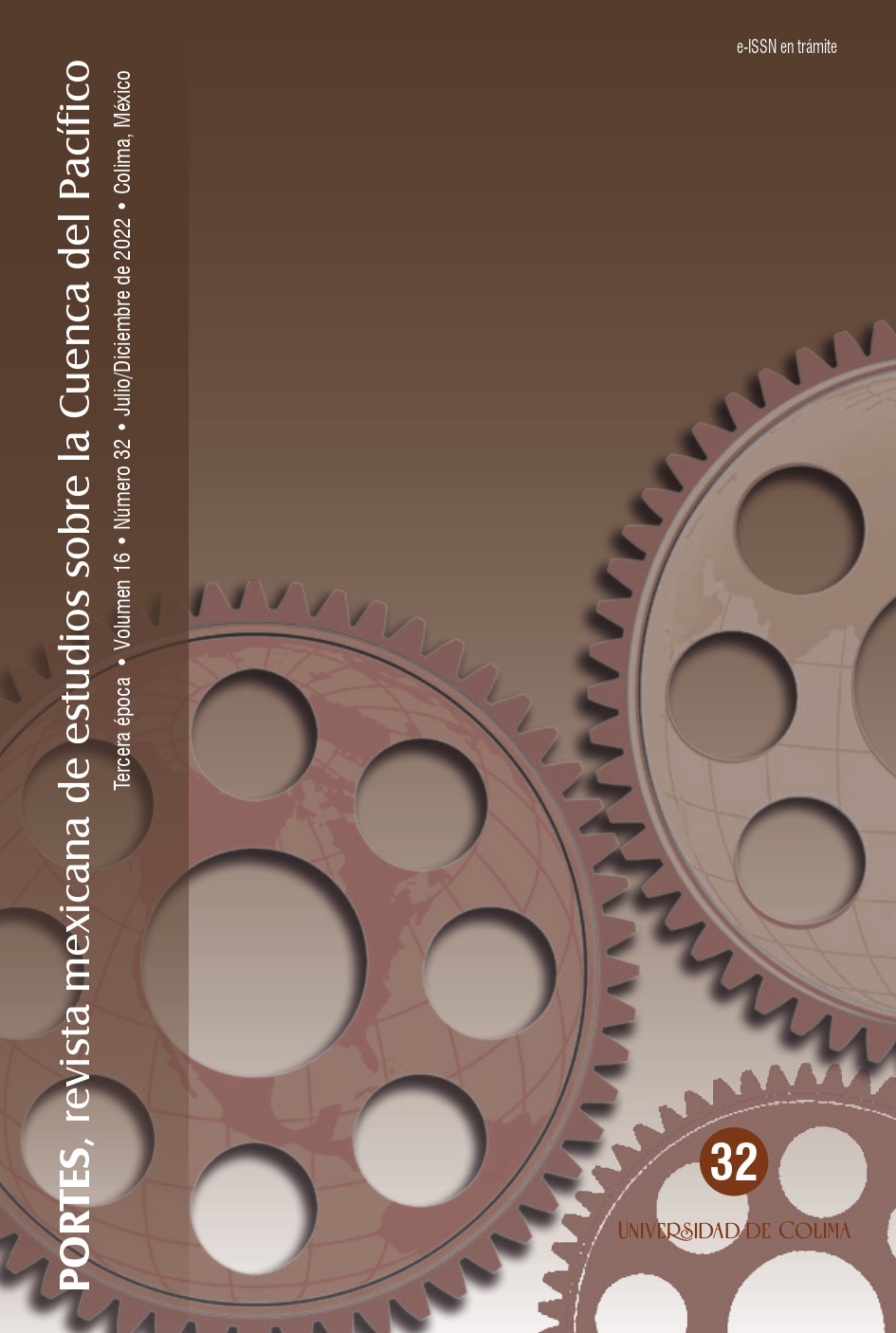Climate crisis and economic growth: an analysis of China’s energy security from 2000 to 2020
Keywords:
energy security, climate policy, renewable energies, fossil fuelsAbstract
This article analyzes the Chinese energy security strategy from 2000 to 2020. To do this, it uses the concept of the International Energy Agency, which establishes the need for investments and a stable supply. Through the study of the Five-Year Plans formulated by the Communist Party of China, energy statistics, and reports from international agencies, the authors conclude that although the country plans to increase its endowment of renewable sources, it does not intend to abandon the use of fossil fuels in the next decade.
Downloads
References
Administración Internacional de Energía (2021). China Country Analysis Brief and Data. https://www.eia.gov/international/overview/country/CHN
Agencia Internacional de Energía (2022). Estadísticas en línea y vista de información por temática. https://www.irena.org/Statistics/View-Data-by-Topic/Capacity-and-Generation/Regional-Trends.
Banco Asiático de Inversión en Infraestructura (BAII) (2022). Project summary, approved projects. https://www.aiib.org/en/projects/summary/index.html
Banco Mundial (2022a). Climate Data Historical. China. Washington: Climate Change Knowledge. https://climateknowledgeportal.worldbank.org/country/china/climate-data-historical.
Banco Mundial (2022b). China. Vulnerabilidades. Washington: Climate Change Knowledge Portal. https://climateknowledgeportal.worldbank.org/country/china/vulnerability
Boute, A. (2019). China’s External Security: Energy Trade and Investment Along the ‘Belt and Road’. An Introduction. Journal of World Investment Trade, 20, 195-220.
Bradsher, K. (2010, 17 de junio). Security tops the environment in China’s Energy Plan. The New York Times. https://www.nytimes.com/2010/06/18/business/global/18yuan.html
Boston University Global Development Policy Center (2021). China’s Global Energy Finance. https://www.bu.edu/cgef/#/2000/Country.
Chauhan, P. (2019). Energy Dimension of the Belt and Road Initiative: Implications for India’s Energy Security. Indian Journal of Asian Affairs, 32(172), 119-152.
Climate Watch (2021a). China First NDC. https://www.climatewatchdata.org/ndcs/country/CHN/overview?document=first_nd
Climate Watch (2021b). China First NDC Revised. https://www.climatewatchdata.org/ndcs/country/CHN?document=revised_first_ndc
Comisión Nacional de Desarrollo y Reforma (NDRC) (2005). Measures for Operation and Management of Clean Development Mechanism Projects in China. Beijing: Comisión Nacional de Desarrollo y Reforma.
Comisión Nacional de Desarrollo y Reforma, Ministerio de Asuntos Exteriores y Ministerio de Comercio (2015). Visions and Actions on jointly building silk road economic Belt and 21st century maritime silk road. https://eng.yidaiyilu.gov.cn/qwyw/qwfb/1084.htm
Convención Marco de las Naciones Unidas sobre Cambio Climático (2016). Adoption of the Paris Agreement. https://unfccc.int/sites/default/files/spanish_paris_agreement.pdf
Convención Marco de las Naciones Unidas sobre Cambio Climático (2021). Clean Development Mechanism: Project Activities. https://cdm.unfccc.int/Projects/index.html
Ellinas, C. (2020). Energy security imperatives mean China has to do what it can to bring in foreign investors. Natural Gas World. https://www.naturalgasworld.com/china-lowers-the-barriers-for-foreign-investors-ngw-magazine-75872
Gilley, B. (2012). Authoritarian environmentalism and China’s response to climate change. Environmental Politics, 21(2), 287-307.
Hao, X., Song, M., Feng, Y. y Zhang, W. (2019). De-Capacity Policy effect on China’s Coal Industry. Energies, 12, 2-16.
Herberg, E.; Kugelman, M.; Len, C. y Yu, K. (2017). Asia’s Energy Security and China’s Belt and Road Initiative. Seattle: The National Bureau of Asian Research.
Hung, E.; Collins, G. y Foss, M. (2020). Open-Source Mapping of China’s Energy Infrastructure. Houston: Rice University Baker Institute for Public Policy. https://www.bakerinstitute.org/opensource-mapping-of-chinas-energy-infrastructure/
Instituto de Estudios de China (2021). Belt and Road. https://merics.org/en/belt-and-road
Instituto Empresarial Americano (2021). Estadísticas en Línea de las Inversiones Internacionales de China 2021. https://www.aei.org/china-global-investment-tracker/
Isoaho, K.; Goritz, A. y Schulz, N. (2017). Governing Clean Energy Transitions in China and India. En Arent, D.; Arndt, C.; Miller, M.; Tarp, F. y Zinaman, O. (eds.). The Political Economy of Clean Energy Transitions (pp-231-249). Oxford: Oxford University Press.
Lai, H. (2016). China’s governance model: Flexibility and Durability of Pragmatic Authoritarianism. Nueva York: Routledge.
Li, H.; Sun, R.; Dong, K.; Dong, X.; Zhou, Z. y Leng, X. (2017). Selecting China’s strategic petroleum reserve sites by multi-objective programming model. Berlín: Springer.
Lin, K. (2017). One Belt One Road and the future of Chinese energy security (Tesis de maestría). Taipei: Universidad Nacional Chengchi. Mathews, J y Tan, H (2018). China’s new Silk Road: is it black or green? http://energypost.eu/chinas-new-silk-road-will-it-contribute-to-export-of-the-black-fossil-fueled-economy/.
Meidan, M. (2021). China’s SPR release a test of mechanism rather than a show of market might. The Oxford Institute for Energy Studies, https://www.oxfordenergy.org/publications/.
Oficina de Información del Consejo de Estado (2020). Energy in the new era of China. Beijing: Central Compilation & Translation Press.
Ong, R. (2007). China’s security interests in the 21st century. New York: Routledge
ONU (1992). Convención Marco de las Naciones Unidas sobre Cambio Climático. http://unfccc.int/resource/docs/convkp/convsp.pdf
Partido Comunista de China (2001). The 10th Five-Year Plan for Economic and Social Development of the People’s Republic of China (2001-2005). Beijing: Central Compilation & Translation Press.
Partido Comunista de China (2006). The 11th Five-Year Plan for Economic and Social Development of the People’s Republic of China (2006-2010). Beijing: Central Compilation & Translation Press.
Partido Comunista de China (2011). The 12th Five-Year Plan for Economic and Social Development of the People’s Republic of China (2011-2015). Beijing: Central Compilation & Translation Press.
Partido Comunista de China (2016). The 13th Five-Year Plan for Economic and Social Development of the People’s Republic of China (2016-2020). Beijing: Central Compilation & Translation Press.
Partido Comunista de China (2021). The 14th Five-Year Plan for Economic and Social Development of the People’s Republic of China (2021-2025). Beijing: Central Compilation & Translation Press.
Programa Asia Pacífico (2017). Futuro del Acuerdo de París. Nuevo rol de China ante retiro de EE.UU. Biblioteca del Congreso Nacional de Chile. https://www.bcn.cl/observatorio/asiapacifico/noticias/nuevo-liderazgo-china-acuerdo-climatico-paris
Rolland, N. (2019). A concise guide to the Belt and Road Initiative. Seattle: National Bureau of Asian Research.
Zhao, J. (2001). Reform of Chinas energy institutions and policies: Historical evolution and current challenges. Massachusetts: Harvard University.
Downloads
Published
How to Cite
Issue
Section
License
Copyright (c) 2022 University of Colima

This work is licensed under a Creative Commons Attribution-NonCommercial-ShareAlike 4.0 International License.
La revista PORTES de la Universidad de Colima se distribuye bajo una Licencia Creative Commons Atribución-NoComercial-CompartirIgual 4.0 Internacional

